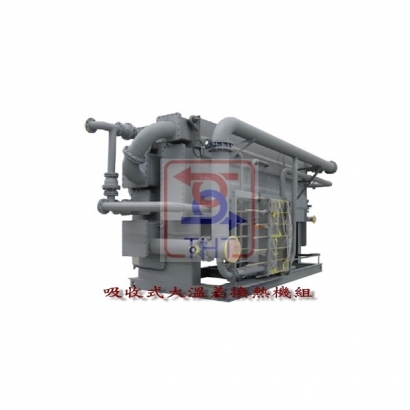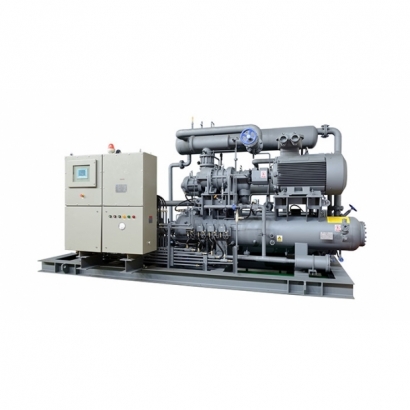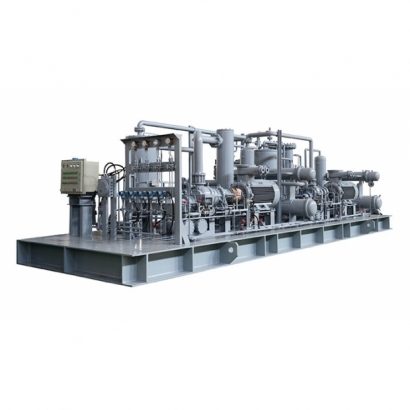MOON-TECH
-
Read More
 Lithium Bromide Absorption Chiller
Lithium Bromide Absorption ChillerLithium Bromide Absorption Chiller
Main Heat Exchange Components of a Lithium Bromide Absorption Chiller:
Evaporator
Condenser
Generator
Absorber
Refrigerant Water Cycle:
Water vapor and concentrated lithium bromide solution are separated in the generator → The vapor condenses into water in the condenser → Passes through a throttle valve →
Evaporates and absorbs heat in the evaporator → Mixes with lithium bromide in the absorber to form a dilute solution → Returned to the generator.
Lithium Bromide Cycle (Performs the function of a compressor):
Water vapor is separated in the generator, forming a concentrated solution → Pressure is reduced through throttling → In the absorber, the solution absorbs water vapor and becomes a dilute solution → The dilute solution is pumped to increase pressure → Returned to the generator.
Advantages
Simple structure with few mechanical moving parts; smooth operation and low vibration.
Easy to operate, with a wide range of cooling capacity adjustment (stepless control from 10% to 100%).
Low energy quality requirements: steam or hot water-driven units can utilize waste heat, residual heat, or other low-grade heat sources.
Thermal energy-driven: power consumption is only 5% of that of a mechanical compression chiller with the same cooling capacity.
Stable cooling efficiency when the heat source is stable, and capable of fully automated control.
Disadvantages
Lithium bromide solution is corrosive to carbon steel, requiring regular maintenance and protection.
The unit operates under vacuum conditions, requiring high airtightness; air ingress will cause performance degradation.
Still requires cooling water for operation.
Conditions for Using Lithium Bromide Absorption Chillers:
Ø Energy-saving!!! No compressor required!!!
Ø Available waste steam pressure ≥ 30 kPa, or waste hot water temperature ≥ 80°C
Ø Waste heat source capacity > 500,000 kcal/hr (approx. 581 kW)
Ø Or equivalent fluid conditions such as waste gas, exhaust air, or wastewater with the above heat parameters
Ø Cooling capacity demand > 100 RT (≈ 350 kW)
Ø Required chilled water temperature ≥ 5°C
Ø Initial investment is approximately twice that of a conventional mechanical chiller
Official Website
Hua Yuan Tai Meng (a subsidiary of MOON-TECH Group)
http://http://www.powerbeijinghytm.com/ -
Read More
 Industrial Low-Temperature Refrigeration System
Industrial Low-Temperature Refrigeration SystemIndustrial Low-Temperature Refrigeration System
MOON-TECH Low-Temperature Refrigeration (Brine) Systems
MOON-TECH provides refrigeration technology covering a temperature range from 0°C to -160°C, ideal for industrial low-temperature applications.
Core Technology
MOON-TECH’s brine refrigeration systems are built around self-developed screw compressors, paired with a variety of evaporators, condensers, and oil circulation systems.
✔ Simple operation
✔ Stable outlet temperature
✔ Optional ASME certification
✔ Optional explosion-proof configuration
Supported Refrigerants
R134a, R507, R410, R404, R23
Ethylene (E1150), Propylene (E1270), Ethane (R170), Propane (R290)
NH₃ (Ammonia, R717), CO₂ (Carbon dioxide, R744)
System Types by Temperature Range
Temperature Range
System Configuration
0°C to -25°C
: Single-stage screw compressor units
-25°C to -50°C
: Two-stage twin screw compressor units or NH₃/CO₂ cascade systems
-50°C to -100°C
: R23 / E1150 (Ethylene) two-stage cascade systems
Available Options
MOON-TECH also offers brine systems using conventional HFC refrigerants or ammonia (NH₃) based on project-specific needs.
-
Read More
 Process Compressor / Booster
Process Compressor / BoosterProcess Compressor / Booster
MOON-TECH’s process gas compressors adopt screw-type technology, available in both oil-injected and oil-free configurations.
Pressure range: from micro pressure up to 6.4 MPa
Certifications available: API 619, CE, and Explosion-proof certification
Industrial process gas compressors or boosters play an essential role in the energy and chemical industries. MOON-TECH offers high-performance compressors suitable for handling a variety of gases such as:
Steam, biogas, refrigerants, analytical gases, flash steam, methane, ethylene, propane, propylene, pentafluoropropane, water gas, ammonia, acetylene, chloromethane, carbon dioxide, vinyl chloride, sulfur dioxide, nitrogen, hydrogen, helium, and other industrial gases for compression and even liquefaction.
These units meet the boosting demands of multiple processes such as light hydrocarbon recovery, gas gathering, LNG liquefaction, and carbon capture across sectors like petroleum and natural gas.
Single Unit Compressor Capacity:
Inlet flow rate: 100–15,000 m³/h
Suction pressure: -0.05–2.0 MPaG
Discharge pressure: 0.1–5.0 MPaG
Motor power: 22–3550 kW
Capacity control method: slide valve
Control range: 15%–100% stepless regulation
Cooling method: air-cooled or water-cooled
Product Applications:
Natural Gas & LNG Industry: NG boosting and transmission, BOG compressors
Chemical and Industrial Process Gas Compression
CCUS (Carbon Capture, Utilization & Storage): CO₂ compressors
Waste Heat Recovery: Steam vapor compressors
Hydrogen Industry: H₂ compressors
Other Specialty Gases: Compressors for N₂, H₂S, etc.



